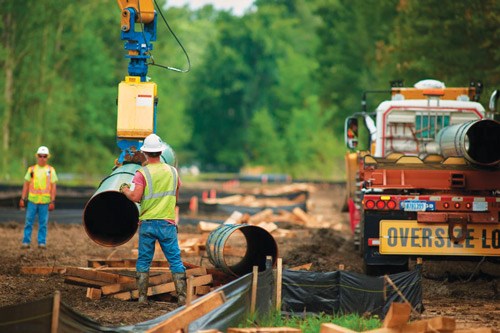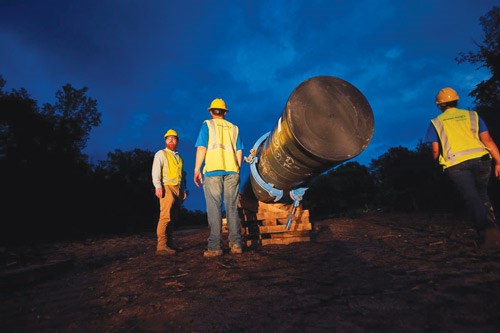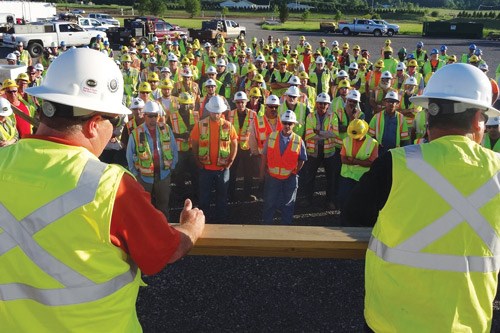May 2019 Vol. 74 No. 5
Features
Consumers Energy Modernizes System with Saginaw Trail Pipeline
Jeff Griffin | Senior Editor
In Michigan, Consumers Energy is modernizing its natural gas system to improve safety and reliability, and a key element is replacing 78 miles of transmission pipeline that passes through three Michigan counties.
The Saginaw Trail Pipeline is a four-phase, $610-million project that will replace 12- and 16-inch pipe—some of it in place since the 1940s—with 94 miles of 24-inch steel pipe. Construction began in 2017 and is projected to be completed in 2021.
Phase 1 was completed in 2017, Phase 2 in 2018. Each construction phase must be completed prior to the upcoming heating season. The first two phases covered 37 miles—18.5 miles in each.
During the first three phases, much of the pipeline route travels through open agricultural areas where open-cut construction is used. The route also goes through highly populated areas and a protected wildlife refuge, where horizontal directional drilling (HDD) limited environmental impact.
While construction in rural areas lacked the complication of numerous buried utilities, field drain tiling is in place. Consumers Energy was responsible for avoiding tile segments and repairing or replacing any that were damaged. Farmers also were compensated for any damage to crops. Welded Construction was the pipeline contractor for the project.
Avoiding inconvenience
Consumers Energy devoted special effort to minimize inconvenience to residents and businesses in construction areas and to build awareness of construction schedules, what to expect and how long an area would be affected.
“We have developed a great formula for making sure everyone is informed,” said Juliet Matko, project manager for Phase 2. “This includes landowner open-house dinners pre- and post-construction, one-on-one communications in the field to address concerns, targeted advertising, a dedicated website, and more.”
Construction was performed by open cut and HDD. In the first two phases, approximately 90 percent was open cut and 10 percent was HDD. The steel pipe was buried four-feet deep in the farmland and three-feet deep in other areas using standard excavators.
“HDD was used when we crossed the Tittabawassee and the Shiawassee rivers, large creeks and large wetlands with standing water,” Matko said. “It also was used at times to cross railroads and major roadways like interstates or M routes. Bore depths averaged 80 feet.”
Six bores for Phase 2 ranged from 1,800 to 4,300 feet long, with an average length of about 3,000 feet. HDD rig equipment sizes ranged from 330,000 pounds to 880,000 pounds of pullback. Southeast Directional Drilling performed the HDD portion of the project.
In Phase 2, the pipeline path went through about two miles of the 9,800-acre Shiawassee National Wildlife Refuge, which is a national sanctuary for migrating birds. Established in 1953, the refuge is protected land comprised of marshes, bottomland hardwood forests and grasslands.
Better than before
Consumers Energy’s goal always is to leave every construction area “better than we found it,” said Matko. Steps to achieve this goal included:
- Environmental inspectors worked onsite to identify and protect sensitive species and their habitats; environmental experts safely relocated critically endangered turtles, as well as frogs and snakes, away from the path of construction. (The herpetologist contracted by Consumers Energy actually rescued a dozen critically endangered Blanding’s turtle eggs, hatched them, and plan to release them back into the refuge when they mature and have a better chance at survival.)
- Crews installed wash bays to clean vehicles and equipment entering the refuge to ensure no invasive species were introduced to the area.
- The company’s foundation donated $5,000 to build an accessible public platform, creating enjoyable nature and wildlife views.
- The project team added native plants, as recommended by the refuge, in approximately 1.3 acres of the habitat.
- The team established barriers around the HDD drilling pads to minimize the effect of noise on the animals in the refuge.
The Saginaw Trail Pipeline project is responsible for about 450 jobs each year. Local and statewide contractors, goods and services were used whenever practical.
Matko attributes planning and continuous communication among all parties involved during construction as keys to the project’s success. In addition, Phase 2 reported 472,057 safe hours worked.
“We are very pleased that the first two phases of this important pipeline project have been completed on time, within budget and in an environmentally sensitive manner,” Matko observed. “These projects are helping enhance our pipeline network so we can continue providing safe, reliable natural gas service to customers across Michigan.”
Consumers Energy is a public utility that provides natural gas and electricity to 6.7 million of Michigan’s 10 million residents in all 68 of the state’s lower peninsula counties. The company has 1.8 million gas customers 1.8 million gas customers in the lower peninsula. •
FOR MORE INFORMATION
Welded Construction, L.P., (419) 874-3548, www.welded.com
Southeast Directional Drilling, (520) 423-2131, www.southeastdrilling.com







Comments